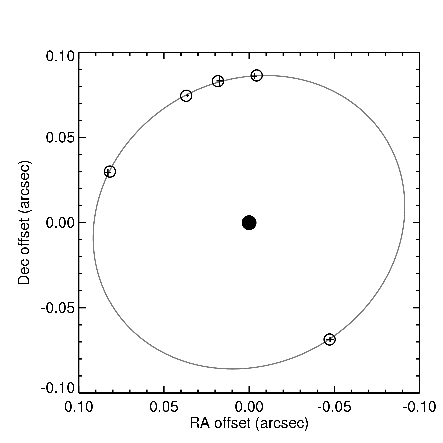
The orbit, mass, size, albedo, and density of (65489) Ceto-Phorcys: A tidally-evolved binary Centaur
Published in 2007: Icarus 191, 286-297.
W.M. Grundy(1), J.A. Stansberry(2), K.S. Noll(3), D.C. Stephens(4), D.E. Trilling(2), S.D. Kern(3), J.R. Spencer(5), D.P. Cruikshank(6), and H.F. Levison(5)
(1) Lowell Observatory, Flagstaff AZ.
(2) Steward Observatory, University of Arizona, Tucson AZ.
(3) Space Telescope Science Institute, Baltimore MD.
(4) Formerly at Johns Hopkins University, Baltimore MD, now at Brigham Young University, Provo UT.
(5) Southwest Research Institute, Boulder CO.
(6) NASA Ames Research Center, Moffett Field CA.
Abstract
Hubble Space Telescope observations of Uranus- and Neptune-crossing object (65489) Ceto/Phorcys (provisionally designated 2003 FX128) reveal it to be a close binary system. The mutual orbit has a period of 9.554 ± 0.011 days and a semimajor axis of 1840 ± 48 km. These values enable computation of a system mass of (5.41 ± 0.42) × 1018 kg. Spitzer Space Telescope observations of thermal emission at 24 and 70 μm are combined with visible photometry to constrain the system's effective radius (109 km) and geometric albedo (0.084). We estimate the average bulk density to be 1.38 g cm-3, consistent with ice plus rocky and/or carbonaceous materials. This density contrasts with much lower densities recently measured with the same technique for three other comparably-sized outer Solar System binaries (617) Patroclus, (26308) 1998 SM165, and (47171) 1999 TC36, and is closer to the density of the saturnian irregular satellite Phoebe. The mutual orbit of Ceto and Phorcys is nearly circular, with an eccentricity ≤ 0.015. This observation is consistent with calculations suggesting that the system should tidally evolve on a timescale shorter than the age of the Solar System.
Figure 3

Fig. 3. Projection of the orbit of Phorcys (gray oval) relative to Ceto's location (black dot) onto the sky plane at the average time of the five HST observations. Points with 1-σ error bars indicate relative astrometry between Ceto and Phorcys measured from the HST images. Open circles are relative positions of Phorcys at the times of the observations as calculated from orbit 1 in Table 3. The spot at the origin and the open circles are scaled to the sizes of Ceto and Phorcys, respectively, derived in Section 4.